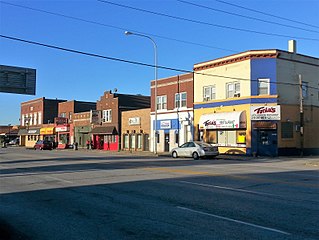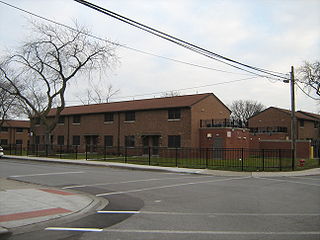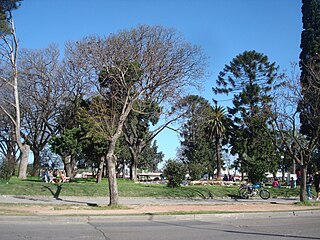
East Chicago is a city in Lake County, Indiana, United States. The population was 26,370 at the 2020 census. The city is home of the Indiana Harbor and Ship Canal, an artificial freshwater harbor characterized by industrial and manufacturing activity. Situated along Lake Michigan, East Chicago is about 18 miles (29 km) from downtown Chicago, Illinois and is just west of Gary, Indiana.

The Calumet River is a system of heavily industrialized rivers and canals in the region between the south side of Chicago, Illinois, and the city of Gary, Indiana. Historically, the Little Calumet River and the Grand Calumet River were one, the former flowing west from Indiana into Illinois, then turning back east to its mouth at Lake Michigan at Marquette Park in Gary. Now the system is part of the Chicago Area Waterway System and through the use of locks flows away from Lake Michigan to the Cal-Sag Channel.

The Indiana Harbor and Ship Canal is an artificial waterway on the southwest shore of Lake Michigan, in East Chicago, Indiana, which connects the Grand Calumet River to Lake Michigan. It consists of two branch canals, the 1.25 miles (2.01 km) Lake George Branch and the 2 miles (3.2 km) long Grand Calumet River Branch which join to form the main Indiana Harbor Canal.

South Deering, located on Chicago's far South Side, is the largest of the 77 official community areas of that city. Primarily an industrial area, a small residential neighborhood exists in the northeast corner and Lake Calumet takes up a large portion of the area. 80% of the community area is zoned as industrial, natural wetlands, or parks. The remaining 20% is zoned for residential and small-scale commercial uses. It is part of the 10th Ward, once under the control of former Richard J. Daley ally Alderman Edward Vrdolyak.

East Side is one of the 77 official community areas of Chicago, Illinois. It is on the far south side of the city, between the Calumet River and the Illinois-Indiana state line, 13 miles (21 km) south of downtown Chicago. The neighborhood has a park on Lake Michigan, Calumet Park, and a forest, Eggers Grove Forest Preserve. The forest preserve has hiking/walking trails, picnic grounds and birdwatching. It is served by U.S. Highway 12, U.S. Highway 20, and U.S. Highway 41.

Riverdale is one of the 77 official community areas of Chicago, Illinois and is located on the city's far south side.

Hegewisch is one of the 77 community areas of Chicago, Illinois, located on the city's far south side. It is bordered by the neighborhoods of Riverdale and South Deering to the west, the East Side to the north, the village of Burnham to the south and the city of Hammond, Indiana to the east. The community area is named for Adolph Hegewisch, the president of U.S. Rolling Stock Company who hoped to establish "an ideal workingman's community" when he laid out the town along a rail line in 1883, six years before Chicago annexed the town.

La Teja is a barrio of Montevideo, Uruguay. The neighborhood has a mix of residential and industrial properties, mostly occupied by working class communities, including with a number of informal settlements built on former industrial sites.

The Grand Calumet River is a 13.0-mile-long (20.9 km) river that flows primarily into Lake Michigan. Originating in Miller Beach in Gary, it flows through the cities of Gary, East Chicago and Hammond, as well as Calumet City and Burnham on the Illinois side. The majority of the river's flow drains into Lake Michigan via the Indiana Harbor and Ship Canal, sending about 1,500 cubic feet (42 m3) per second of water into the lake. A smaller part of the flow, at the river's western end, enters the Calumet River, and through the Illinois ultimately drains into the Mississippi River.
North Hammond is a neighborhood in western Hammond, Indiana, north of the Grand Calumet River and south of Wolf Lake. It is bounded to the south by Central Hammond, to the west by the Chicago neighborhood of Hegewisch, to the north by Robertsdale, and to the east by East Chicago. The neighborhood's boundaries correspond to Hammond's Planning District II. The neighborhood is traversed by the Indiana Toll Road, which has an exit into the neighborhood at Calumet Avenue, and by the South Shore Line railroad. Passenger trains for the Northern Indiana Commuter Transportation District stop at Hammond Station in the neighborhood.

Robertsdale is a neighborhood in northernmost Hammond, Indiana, north of 129th Street and south of Lake Michigan. It is bounded to the south by Pulaski Park, to the west by the Chicago neighborhood of East Side, to the north by Lake Michigan, and to the east by the cities of Whiting and East Chicago. The neighborhood's boundaries correspond to Hammond's Planning District I. The neighborhood is traversed by the Indiana Toll Road, which has an exit into the neighborhood at the Indianapolis Boulevard immediately east of the state line. Amtrak passenger trains pass through Hammond/Whiting station in the neighborhood.
Roxana, sometimes spelled Roxanna, is a neighborhood in southwestern East Chicago, Indiana, south of the Grand Calumet River and north of Michigan Street. It is the only East Chicago neighborhood located south of the Grand Calumet. As of 2013, it was home to approximately 1032 people, of whom 6.5% were Hispanic and 8% were African American.
New Addition, also called West Harbor, is a small triangular neighborhood in the Indiana Harbor section of East Chicago, Indiana, west of Kennedy Avenue, east of the Indiana Harbor and Ship Canal, and north of United States Route 12. As of 2013, it was home to approximately 263 people.
Indiana Harbor or The Harbor is the portion of East Chicago, Indiana, located east of the Indiana Harbor and Ship Canal, as opposed to "East Chicago proper" which is located west of the canal. It contains several distinct neighborhoods, including New Addition, Sunnyside, and North Harbor. The Calumet neighborhood is west of the Canal but sometimes considered distinct from "Indiana Harbor proper".
North Harbor is a neighborhood in northeastern East Chicago, Indiana. It constitutes the portion of the Indiana Harbor section north of 138th Street. The neighborhood is home to one of the highest concentrations of affordable housing in the United States.
The Brickyard was a neighborhood in the Indiana Harbor section of East Chicago, Indiana, near the intersection of Kennedy Avenue and Gannister Court. It stood for much of the 20th century, housing approximately 30 primarily African American families, until the City of East Chicago demolished it in the mid-1990s due to contamination from the adjacent Pollution Control Industries (PCI) hazardous waste mixing facility.

Northside or North Side is a neighborhood in western East Chicago, Indiana. Together with Southside and Roxana, it makes up "East Chicago proper," as distinct from Indiana Harbor. The population is 72% Hispanic and 21% African American. The neighborhood has one of the highest rates of owner-occupied homes in the city. Notable landmarks in Northside include the East Chicago City Hall and Central High School.

Southside or South Side is a neighborhood in western East Chicago, Indiana. Together with Northside and Roxana, it makes up "East Chicago proper," as distinct from Indiana Harbor. The population is 64% Hispanic and 25% African American. The neighborhood is home to 20% of East Chicago's population. The neighborhood is dominated by residential properties, with relatively few institutional buildings.
Prairie Park is a neighborhood in the Indiana Harbor section of East Chicago, Indiana. It is bounded on the north by U.S. 12, and on the south by Indiana 312. To the west, it looks across Elm Street at the Washington Park neighborhood, and to the east it is bounded by the Cline Avenue expressway and industrial northern Gary beyond.
The U.S. Smelting and Lead Refinery Inc. site, commonly known as USS Lead, is a superfund site located in East Chicago, which is located in northwest Indiana. The site includes part of the former USS Lead facility along with nearby commercial, municipal, and residential areas. Originally the site was used as a lead ore refinery with the surrounding businesses at the time performing similar operations The primary contaminants of concern for this area are lead and arsenic. The site is currently undergoing testing and remediation. This Superfund site is broken down into two Operable Units. The first, OU1, has been divided into three zones, these being public housing complex and residential properties. OU2 includes soil at the former USS Lead facility, as well as groundwater in and around the site.










